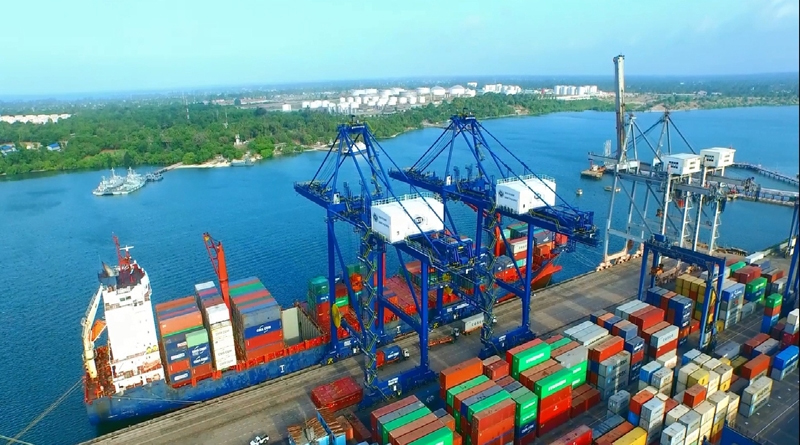The Mombasa Port throughput registered a slight decline in 2020
Data from the Northern Corridor Transport Observatory reveals that the Port of Mombasa sustained its performance in January-December 2020 with a slight decline compared to its throughput in the corresponding period in 2019. The hub recorded a throughput of 34 million metric tonnes (MT) in 2020, a 1% decline from 34.4 million MT handled in 2019. However, this was 5% short of the projected 35.9 million MT in total throughput and 1.49 million twenty-feet equivalent units (TEUs) in container traffic in 2020. The sustained performance was facilitated by previously achieved advancements on soft and hard infrastructure at the port that enhanced its efficiency.
In terms of containers handled, the port of Mombasa during the period January–December 2020 recorded a total of 1,359,579 TEUs compared to 1,416,654 TEUs in 2019, registering a 4.0% decline by 57,076 TEUs.

Mombasa Port recorded a 1% decline in total throughput in 2020.
The COVID-19 pandemic struck when the Northern Corridor region was performing well. In January-December 2019, the Port of Mombasa recorded 34,439,264 tons with a growth of 3,515,976 tons, 11.4% compared to the 30,923,288 tons registered in the corresponding period in 2018. These numbers were on an upward trend for January and February 2020. However, they dipped from March 2020, with the Coronavirus disease declaration as a pandemic and the subsequent worldwide sluggish economic activities occasioned by suppression of demand due to lockdowns and travel restrictions. Later in the year, as the nations started to adapt to the ‘new normal’, the port throughput started to moderately resume to pre-COVID-19 levels.
The Northern Corridor Transport Observatory, which is a performance monitoring tool, records that during the COVID-19 period, various industries faced challenges along their supply chain such as raw material shortages, lead time issues, reduced working hours, equipment and labour shortages, as well as truck-transport capacity constraints.
Out of the 34 million MT handled in January-December 2020, 81.5% were imports. Exports constituted 12.2% and transhipments 6%, while restows stood at 0.3%. As a percentage share of the total throughput, imports recorded a 1.5% rise from 27.6 million MT in 2019 to 28 million MT in 2020. Exports reduced from 4.3 million MT to 4 million MT while transhipment traffic struggled to meet the record growth witnessed in 2019 and dropped from 2.5 million MT to 2 million MT in 2019 and 2020, respectively.
Further, Transport Observatory reports reveal that during January-December 2020, 64.2% of the port throughput was domestic cargo (Kenya bound), transit cargo was 29.9%, and transhipment accounted for 6% of the total market share. Total transit cargo through the Port of Mombasa posted a growth of 2.2%, recording 10.2 million MT against 10 million MT handled in 2019.
Concerning transit cargo share per Northern Corridor Member State, Uganda remains the largest transit market share at 75.7%. South Sudan stands at 10.4%, DRC at 7.2 %, Rwanda at 4.2%, and Burundi takes 0.01%. Other partner States in the region constituted 2.5% of the total transit volumes through the port of Mombasa.
Transit volumes for Uganda and Burundi reduced by 5.4% and 69.9% respectively in 2020 against the volumes recorded for 2019, while transit volumes to Rwanda, South Sudan and DR Congo increased by 84.5%, 37.1% and 33.7%, respectively.
In general, the performance of the Port of Mombasa and the entire Northern Corridor was affected by disruptions caused by restrictions introduced in response to the COVID-19 pandemic, undermining the smooth movement of trade flows and supply chain operations and significantly threatening to erode the trade and transport facilitation gains achieved over the years.
However, the Mombasa Port performance in 2020 when Coronavirus disease ravaged world economies is a clear indicator of the monumental infrastructural developments along the corridor. Tremendous strides have been made to enhance efficiency, including infrastructure developments at the port, faster clearance of goods with the implementation of the Single Customs Territory (SCT) across the region, development of Regional Electronic Cargo and Driver Tracking Systems, implementation of COMESA Trade Facilitation Instruments, and installation of the High-Speed Weigh in Motion (HSWIM) improving the weighbridge crossing time. Currently, 23 OSBPs have been identified across the region, with 15 OSBPs already established. Business processes have also been significantly automated, and the quality of road conditions along the corridor improved.
The implementation of the Standard Gauge Railway (SGR) in Kenya and the establishment of Inland Container Depots in Nairobi and Naivasha have contributed to the speedy evacuation of cargo from the port.
While the long-term economic impact of COVID-19 remains uncertain, the ongoing works at the port of Mombasa to construct new berths, linking of Naivasha ICD to the Metre Gauge Railway (MGR), the kick-off of trading under the African Continental Free Trade Area (AfCFTA), and the envisioned Dongo Kundu Special Economic Zone, among other initiatives, are set to improve the Mombasa Port efficiency translating to even better performance.

